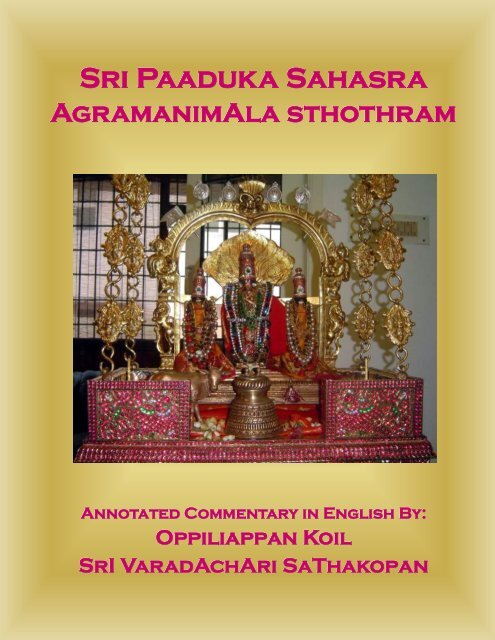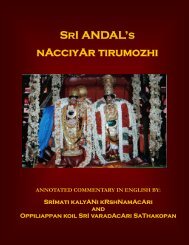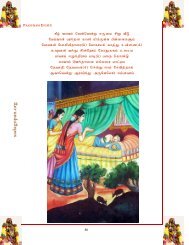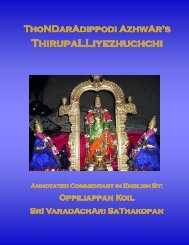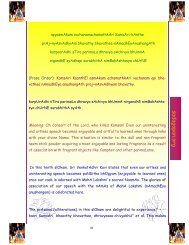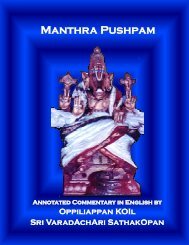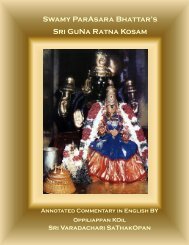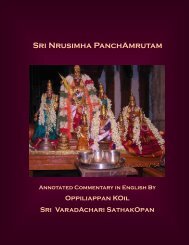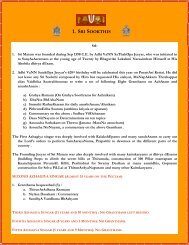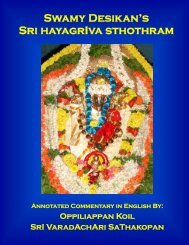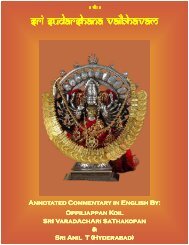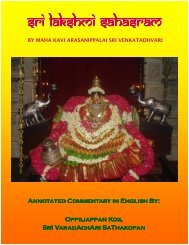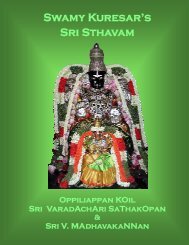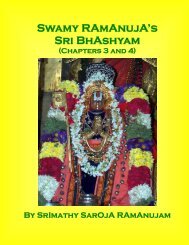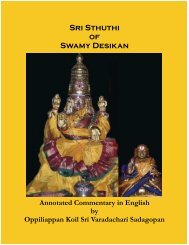Sri Paaduka Sahasra - Sundarasimham
Sri Paaduka Sahasra - Sundarasimham
Sri Paaduka Sahasra - Sundarasimham
Create successful ePaper yourself
Turn your PDF publications into a flip-book with our unique Google optimized e-Paper software.
<strong>Sri</strong> <strong>Paaduka</strong> <strong>Sahasra</strong><br />
AgramanimAla sthothram<br />
Annotated Commentary in English By:<br />
Oppiliappan Koil<br />
SrI VaradAchAri SaThakopan
sadagopan.org
SRI RANGANATHA PADUKA SAHASRA AGRAMANIMAALA<br />
STHOTHRAM<br />
INTRODUCTION<br />
Swamy NammAzhwAr is recognized and revered in our tradition as the Paadhukais of Lord<br />
RanganAthan (SrIman NaarAyaNan) of BhUlOka Vaikuntam (SrIrangam).<br />
Swamy Desikan composed in one Yaamam of a night (3 hours) at SrIrangam, 1008 slOkams<br />
saluting the Vaibhavam of Swamy NammazhwAr as the Paadha Rakshais /PaadhukAs of Lord<br />
RanganAthan.<br />
“AYINDHAI DESIKAN”<br />
THE BIRTH OF SRI RANGANATHA PAADHUKA SAHASRAM (SRPS)<br />
These 1008 verses were composed as a response for a challenge from a jealous SrI Vaishnava<br />
AchArya as to who can compose 1008 slOkams on a divine subject during the course of a night.<br />
The jealous challenger chose to compose his 1008 on the Lotus feet of Lord RanganAthan.<br />
Swamy Desikan accepted this challenge and elected to compose his 1008 slOkmas on the<br />
glories and significance of the sandals (Paadhukais) that protect the Lord's Thiuvadi during<br />
His varied sanchArams.<br />
In less than 3 hours, Swamy Desikan completed his task of creating the 1008 verses on the<br />
subject of his choice. The contestant was able to compose a mere 300 slOkams during the same<br />
time.<br />
1<br />
sadagopan.org
sadagopan.org<br />
As the day broke, the judges declared Swamy Desikan as the winner in the contest that Swamy<br />
Desikan did not seek. We are indeed the beneficiaries of this contest, since Swamy Desikan's<br />
SrI RanganAtha PaadhukA Sahsram (1008 SlOkams) contain deep doctrines of SrI VaishNavam<br />
in the format of eulogy to Lord RanganAthan's Paadhukai.<br />
THE RELEVANCE OF SRPS<br />
At this time of the Lord's Thiru Adhyayana Uthsavam reaching its climax in Swamy<br />
NammAzhwAr's Moksham, it is appropriate to celebrate the SrI RanganAtha PaadhukA<br />
<strong>Sahasra</strong>m, which is largely about Swamy NammAzhwAr's ThiruvAimozhi and other<br />
Prabhandhams .<br />
THE 32 PADDHATHIS OF SRPS & AGRAMANI MAALA STHOTHRAM<br />
The 1008 slOkams are housed in 32 Paddhathis or chapters. Always, the first slOakm of each<br />
Paddhathi is set up in the Anushtup Metre. When these first slOkams of the 32 individual<br />
Chapters (Paddhathis) are recited every day; it confers Sarva mangaLams (all auspiciousness)<br />
on the reciter. This assembly of the 32 first slOkams is known as SrI PaadhukA <strong>Sahasra</strong><br />
AgramaNi MaalA sthothram.<br />
adiyEn will share the meanings of these 32 slOkams so the bhakthAs can appreciate and enjoy<br />
the meanings of these anushtup slOkams positioned at the head of each of the following 32<br />
chapters of SrI RanganAtha PaadhukA <strong>Sahasra</strong>m :<br />
1. PrasthAva Paddhathi 2. SamAkhyA Paddhathi<br />
3. PrabhAva Paddhathi 4. SamarpaNa Paddhathi<br />
5. PrathiprasTAna Paddhathi 6. AdhikAra Parigraha Paddhathi<br />
7. AbhishEka Paddhathi 8. NiyAtanA Paddhathi<br />
9. VaithALika Paddhathi 10.SrungAra Paddhathi<br />
11. SanchAra Paddhathi 12.Pushpa Paddhathi<br />
13. ParAga Paddhathi 14. Naadha Paddhathi<br />
15. Rathna SaamAnya Paddhathi 16. Bahurathna Paddhathi<br />
17. PadhmarAga Paddhathi 18.MukthA Paddhathi<br />
19. Marataka Paddhathi 20. Indraneela Paddhathi<br />
21. BhimBha-PrathBhimBha Paddhathi 22. Kaanchana Paddhathi<br />
23. SEsha Paddhathi 24. Dhvandhva Paddhathi<br />
25. SannivEsa Paddhathi 26.YanthrikA Paddhathi<br />
2
27. REkhA Paddhathi 28. SubhAshithA Paddhathi<br />
29. PrakeerNa Paddhathi 30. Chithra Paddhathi<br />
31. NirvEdha Paddhathi 32. Phala Paddhathi.<br />
SRI RANGANATHA PAADHUKA SAHASRA AGRA MANI MAALA<br />
Here are those 32 slOkams and their brief meanings.The detailed meanings of the SlOkams are<br />
covered in the respective Paddhathis, in the Paddhathis section of <strong>Sri</strong> RanganAtha PaadhukA<br />
<strong>Sahasra</strong>m webpages.<br />
INDIVIDUAL AGRA MANIS OF THIS MAALA<br />
SLOKAM 1:<br />
sNt> ïI>r¼àuWvIzcr[Ça[zeora>,<br />
jyiNt Éuv[Ça[pdp»jrE[v>.1.<br />
Santha: SrIranga-pruTveesa charanathrANa SEkharA:<br />
Jayanthi bhuvana-thrANa padhapankaja rENava:<br />
MEANING:<br />
Great men adorn on their heads the PaadhukAs of Lord RanganAtha (The Lord's Paadhukais/<br />
SatAri= Swamy NammAzhwAr). These pious men adorn the Paadhukais with high reverence.<br />
The Lord's SatAri makes them shine gloriously among their fellow men. The dust from the feet<br />
of such BhAgavathAs --adorning the Lord's SatAris on their heads -- is potent enough to grant<br />
protection (Salvation too) for the beings of the three worlds.<br />
SLOKAM 2:<br />
vNde ivZ[upadsÄ< tèui;< ta paÊkam!,<br />
ywawaR zQijTs.2.<br />
vandhE VishNu padhAsaktham tamrushim thaam cha PaadhukAm<br />
yaTArTA SaThajith-samkjn~A macchittha vijayAdhyayO:<br />
MEANING:<br />
adiyEn pays obeisance to Swamy NammAzhwAr (SatakOpa) and the Paadhukais of the Lord.<br />
Both are closely attached to the feet of the Lord. Both have the name of SatAri or Satajith. Both<br />
got this name of SatAri because both conquered a dushtan. Paadhukais conquered the dushtan<br />
by the name of Satan and Swamy NammAzhwAr conquered this dushtan (adiyEn), who<br />
strayed away from the SAstrEic injunctions established by Lord RanganAtha.<br />
3<br />
sadagopan.org
sadagopan.org<br />
SLOKAM 3:<br />
vNde td r¼nawSy maNym! paÊkyaeyuRgm!,<br />
%Útanamvnit> ntanam! yÇ caeÚit>.3.<br />
VandhE Tadh-RanganATasya mAnyam paadhukAyOr-yugam<br />
unnatAnAm-avanathi: nathAnAm yathra chOnnathi:<br />
NAMMAZHWAR—SRIRANGAM<br />
MEANING:<br />
I salute the celebrated pair of Paadhukais of the Lord of SrIrangam, which make the tall<br />
become small (humble) and vice-versa. Swamy Desikan means that those, who are haughty, are<br />
reduced in rank and are humbled by the Paadhukais. Similarly , those who humbly worship the<br />
Paadhukais get elevated and receive the full blessings of the Lord. Even the Lord Himself<br />
becomes taller , when He adorns His Paadhukais and becomes shorter, when He steps down<br />
from them.<br />
4
SLOKAM 4:<br />
Éjam> paÊke ya_yam! ÉrtSya¢jStda,<br />
àay> àitàya[ay àaSwainkmkLpyt!.4.<br />
bhajAma: PaadhukE yAbhyAM BharathasyAgrajastadhA<br />
prAya: prathi-prayANAya prAsTaanikam akalpayath<br />
MEANING:<br />
We salute the Paadhukais, which were given to BharathA (at Chitrakootam) by Lord<br />
Raamachandra. Those Paadhukais of the Lord were sent as a parasthAna vasthu by RaamA in<br />
anticipation of His safe return to AyOdhyA fourteen years later. ParasthAnam is a practice,<br />
where one who can not start on a journey at an auspicious time sends one or more of his<br />
property ahead by practicing parasthAnam/prAsTAnikam (the ritual to be observed in the<br />
context of travel).<br />
PAADHUKAS TO BHARATHA<br />
5<br />
sadagopan.org
sadagopan.org<br />
SLOKAM 5:<br />
àzSte rampada_yam! paÊke pyuRpaSmhe,<br />
Aan&z saketvaisiÉ>,<br />
ANvyVyitreka_yamNvmIyt vEÉvm!.6.<br />
SRI RAMA PAADAM, MELKOTE<br />
6
adIshtE pAdukA sA mE yasyA: sAktavAsibhi: !<br />
anvayavyatirEkAbhyAmanmIyata vaibhavam !!<br />
MEANING:<br />
THAT PAADUKA is my topmost Goddess - whose greatness was correctly inferred by the<br />
people of Ayodhya in the sense that when <strong>Paaduka</strong> ruled, all in the nation was good and<br />
auspicious; and when <strong>Paaduka</strong> was not the ruler, all went amiss.<br />
SLOKAM 7:<br />
paih n> paÊke ySya> ivxaSyn! AiÉ;ecnm!,<br />
AaiÉ;ecink< Éa{f< c³e ram> àdi][m!.7.<br />
pAhi na: pAdhukE! yasyA: viDhAsyan aBhishechanam<br />
ABhiShEchanikam BhANdam chakrE rAma: pradakshiNam<br />
MEANING:<br />
Oh <strong>Paaduka</strong>! May you protect us! We recall that when Rama circumambulated the religious<br />
collection of materials assembled, on the eve of His departure to the forest, He had visualized,<br />
presumably so, this event-namely, the coronation of yourself now.<br />
SLOKAM 8:<br />
AiÉ;ekaeTsvat! tSmat! ySya inyaRtnaeTsv>,<br />
ATyirCyt ta< vNde ÉVya< Értdevtam!.8.<br />
aBhiShEkOthsavAth thasmAth yasyA niryAthanOthsava:<br />
athyarichyatha thAm vandhE BhavyAm BharathadhevathAm<br />
MEANING:<br />
I pay homage to that <strong>Paaduka</strong>, the Deity of Bharata, the auspiciousness-conferring Deity,<br />
whose Restoration-festival (of being returned to Rama's Feet) was more grand than the<br />
coronation festival.<br />
SLOKAM 9:<br />
nmSte paÊke pu
sadagopan.org<br />
and announcers, say, at the time of the Lord wearing You who is the bridge for humans to cross<br />
the ocean of samsara.<br />
SLOKAM 10:<br />
zaEre> ï&¼arceòana< àsUit< paÊka< Éje,<br />
yame; Éu“e zuXdaNtat! pUv¡ píadip àÉu>.10.<br />
soUrE: shrungArachEShtAnAm prasUthim pAdhukAm BhajE<br />
yAmESha BhunkthE shuDdhAnthAth pUrvam paschAdhapi praBhu:<br />
THE LORD ENJOYS THE PAADUKAS<br />
8
MEANING:<br />
Oh <strong>Paaduka</strong> Devi! My humble prostrations to you, who create for the great creator Lord<br />
Ranganatha, a variety of amorous activities; indeed the Lord enjoys You passionately, before<br />
and after in between his love-plays in the harem!<br />
SLOKAM 11:<br />
A¢tSte gim:yaim m&ÐNtI k…zk{qkan!,<br />
#it sIta=ip yÖ¯iÄimye; à[maim tam!.11.<br />
agrasthasthE gamiShyAmi mrudhnanthI kushakaNtakAn<br />
ithi sIthApi yadhvrutthimiyESha praNamAmi thAm<br />
MEANING:<br />
I prostrate to that <strong>Paaduka</strong> Devi, whose duty even Sita wished to perform, when she said, "I<br />
shall go ahead of You (the Lord), trampling, with the feet, on the grass and thorns on the way".<br />
SLOKAM 12:<br />
zaEre> sÂarkale;u pu:pv&iòidRvZCyuta,<br />
pyRvSyit yÇEv àp*e ta< pdavnIm!.12.<br />
soUrE: sanchArakAlEShu puShpavruShtirdhivashchyuthA<br />
paryavasyathi yathraIva prapadhyE thAm padhAvanIm<br />
MEANING:<br />
I surrender myself to that <strong>Paaduka</strong> at which the rain of flowers showered by the Devas<br />
ultimately resides.<br />
SLOKAM 13:<br />
paNtu v pÒnaÉSy paÊkakei¦pa,<br />
AhLyadehinmaR[pyaRyprma[v>.13.<br />
pAnthu: va: padhmanABhasya pAdhukAkELipAmsava:<br />
ahalyAdEha nirmANaparyAyaparamANava:<br />
MEANING:<br />
May the dust of the <strong>Paaduka</strong>'s movement protect you all, the dust which perhaps proved to be<br />
the atoms to generate the body of Ahalya.<br />
9<br />
sadagopan.org
sadagopan.org<br />
SLOKAM 14:<br />
ïutInam! ÉU;[ana< te z»e r¼eNÔpaÊke,<br />
imw> s'"zRsÃat< rt> ikmip iziÃtm!.14.<br />
shruthInAm BhUShaNanAm thE shankE rangEndhra pAdhukE!<br />
miTha sanGarshasanjAtham raja: kimapi shinjitham<br />
MEANING:<br />
Oh Ranganatha <strong>Paaduka</strong>! The musical sound generated from the gemstones on You, as the<br />
Lord walks through the streets, looks as though it were produced by mutually competing Veda<br />
branches, serving You as adornment, praising You.<br />
SLOKAM 15:<br />
%dicR;Ste r¼eNÔpadavin bihmR[In!,<br />
PAADUKA ADORNED WITH GEMS<br />
ANtmRi[rvm! ïuTva mNye raemaiÂta³…tIn!.15.<br />
10
udharchiShasthE rangEndhrapAdhAvani! BahirmaNIn<br />
antharmaNiravam shruthvA manyE rOmAnchithAkruthIn<br />
MEANING:<br />
Oh Ranganatha-<strong>Paaduka</strong>! The external gems on You emit a rare splendor now. What is the<br />
reason? Oh it is due to their horripilation on hearing the melodious Nada caused by the interior<br />
gems.<br />
SLOKAM 16:<br />
muobaøépade_yae v[aRn! s&òvt> àÉae>,<br />
àp*e paÊka< rÆEVyR´v[RVyviSwitm!.16.<br />
muKhabAhUrUpAdhEBhyO varNAn sruShtavatha: praBhO:<br />
prapadhyE pAdhukAm rathnaIrvyakthavaraNavyavasThithim<br />
MEANING:<br />
I surrender to <strong>Paaduka</strong> which exhibits the different colours from different gems on it-in the<br />
same manner as the Lord gave rise to the 4 varnas (Brahmana, Kshatriya, Vaisya and Sudra)<br />
from His Face, Arms, Thighs, and Feet respectively.<br />
SLOKAM 17:<br />
àp*e r¼nawSy paÊka< pÒraig[Im!,<br />
pdEkinyta< tSy pÒvasaimvapram!.17.<br />
prapadhyE ranganathasya pAdhukAm padhmarAgiNIm<br />
padhaIkaniyathAm thasya padhmavAsAmivAparAm<br />
MEANING:<br />
I surrender myself to <strong>Paaduka</strong>, who is another Mahalakshmi, being padmaragini (having<br />
Padmaraga=ruby gems) like Lakshmi (loving to live in the lotus), and who is ever bound to the<br />
Lord's feet only (like Lakshmi ever being one participating in all the roles, such as the control<br />
of all worlds, being Seshi, etc., permanently sharing in His duty).<br />
SLOKAM 18:<br />
bXdana< yÇ inTyana< mu´anamIñrSy c,<br />
àTy]m! ze;zei;Tv< sa me isXdYtu paÊka.18.<br />
baDdhAnAm yathra nithyAnAm mukthAnAmIshvarasya cha<br />
prathyaksham shEShashEShithvam sA mE siDdhayathu pAdhukA<br />
11<br />
sadagopan.org
sadagopan.org<br />
MEANING:<br />
There is a special relationship between Bound ones, Nitya sooris, and Emancipated souls on<br />
the one hand and the Lord on the other. They are all sesha bhootas (lieges ever) and He, the<br />
master, the Seshi. The paaduka explicitly proclaims this by containing pearls (Muktas), ever<br />
(Nitya) bound (Baddha) on itself and behaving as a Sesha to the Master. May that paaduka be<br />
my goal!<br />
SLOKAM 19:<br />
vNde gaéTmtI— v&Åya mi[StaemEí paÊkam!,<br />
PAADUKA IS MAHALAKSHMI<br />
yya inTym! tu¦Syev hirtÅvm! àkaZyte.19.<br />
vandhE gAruthmathIm vrutthyA maNisthOmaIscha pAdhukAm<br />
yayA nithyam thuLasyEva harithathvam prakAshyathE<br />
MEANING:<br />
I pay obeisance to <strong>Paaduka</strong>, inset with green gems-emeralds, which have Garuda as their<br />
devata. Both <strong>Paaduka</strong> and Garuda are alike in their duty assignment and in appearance /<br />
12
constitution. <strong>Paaduka</strong> resembles Tulasi too. Whereas <strong>Paaduka</strong> exhibits Hari-tatva (the<br />
principle called Hari), Tulasi exhibits Harita-tatva (the greennenss).<br />
SLOKAM 20:<br />
hir[a hirnIlEí àityÆvtI— sda,<br />
AyÆl_yinvaR[amaïye mi[paÊkam!.20.<br />
PAADUKA RESEMBLES THULASI<br />
hariNA harinIlaIscha prathiyathnavathIm sadhA<br />
ayathnalaBhyanirvANAmAshrayE maNipAdhukAm<br />
MEANING:<br />
The <strong>Paaduka</strong> obtains ornamentation from the Lord and from the sapphire gems. This is a<br />
permanent feature, as also its effective effortful life. Ironically, it will secure fruits without<br />
effort. It guides us also in effortless securing Moksha. I surrender to that <strong>Paaduka</strong>!<br />
13<br />
sadagopan.org
sadagopan.org<br />
SLOKAM 21:<br />
zaEre> zuXdaNtnair[a< ivharmi[dpR[m!,<br />
àsÄeirv s
SLOKAM 23:<br />
s&òa< ÉUmavnNten inTym! ze;smaixna,<br />
Ah< sMÉavyaim TvamaTmanaimv paÊke.23.<br />
sruShtAm BhUmAvananthEna nithyam sEShasamADhinA<br />
aham samBhAvayAmi thvAmAthmAnamiva pAdhukE!<br />
MEANING:<br />
Oh <strong>Paaduka</strong>! I regard You as a Jivatma 'created' in this world as an example of how servile a<br />
soul ought to be, with respect to the Lord; this creation may be said to be by Adisesha himself,<br />
(who is the finest example of Seshatva) or by the Lord Himself. [Ananta=Adisesha, as well as<br />
the Lord].<br />
SLOKAM 24:<br />
àp*e paÊkaêp< à[vSy klaÖym!,<br />
Aaet< imtimd< yiSmÚnNtSyaip tTpdm!.24.<br />
prapadhyE pAdhukArUpam praNavasya kalAdhvayam<br />
Otham mithamidham yasminnananthasyApi thathpadham<br />
MEANING:<br />
I pay obeisance to the twin Padhukas, which together represent the pranava composed of the<br />
infinite Paramatma and the limited Jivatma (represented by A and M respectively); the Lord's<br />
foot (of infinite course in Trivikrama form) and the Lord of infinite nature are also intertwined.<br />
I PAY OBEISANCE TO THE PAADUKAS<br />
15<br />
sadagopan.org
sadagopan.org<br />
SLOKAM 25:<br />
A[aer[IysI— iv:[aemRhtae=ip mhIysIm!,<br />
àp*e paÊka< inTy< tTpdenEv siMmtam!.25.<br />
aNOraNIyasIm viShNOrmahathOpi mahIyasIm<br />
prapadhyE pAdhukAm nithyam thathpadhEnaIva sammithAm<br />
MEANING:<br />
I cling to the <strong>Paaduka</strong> - as my only shelter - which <strong>Paaduka</strong> adapts a form to suit the Lord's<br />
Feet, whether he is in a mini-particle size as an atom or in a mammoth-sized form - this the<br />
<strong>Paaduka</strong> does as the Lord himself does.<br />
SLOKAM 26:<br />
%d¢yiÙka< vNde paÊka< yiÚveznat!,<br />
%pyRip pd< iv:[ae> àTyaidòàsaxnm!.26.<br />
udhagrayanthrikAm vandhE pAdhukAm yannivEshanAth<br />
uparyapi padham viShNO: prathyAdhiShtaprasADhanam<br />
MEANING:<br />
I pay obeisance to the <strong>Paaduka</strong>, which has got an upward-directed knob (between the 1st and<br />
second toes), that serves as an embellishment to the Lord's foot on the upper side as <strong>Paaduka</strong><br />
is below; in fact, there is no need for any other ornament for the feet when this knob is there.<br />
SLOKAM 27:<br />
sUcyNtI— SvreoaiÉrnaleOysrSvtIm!,<br />
AleonIysaENdyaRmaïye zaEirpaÊkam!.27.<br />
sUchayanthIm svarEKhABhiranAlEKhyasarasvathIm<br />
alEKhanIyasoUndharyAmAshrayE shoUripAdhukAm<br />
MEANING:<br />
I cling to the <strong>Paaduka</strong>s of the Lord-the <strong>Paaduka</strong> that possesses streaks which represent the<br />
unwritten Vedas and which are of a beauty that cannot be depicted by writing.<br />
SLOKAM 28:<br />
klasu kaóamaitón! ÉUçe sMbiNxnamip,<br />
paÊka r¼xuyRSy ÉrtaraXyta< gt.28.<br />
16
kalAsu kAShTAmAthiShTan BhUmrE sambanDhinAmapi<br />
pAdhukA rangaDhuryasya BharathArADhyathAm gathA<br />
MEANING:<br />
One who is adept in the field of fine arts bestows a kind of popular respectability even on his<br />
near and dear ones. (The moon, with 16 digits, the full moon, makes the ocean swell in joy; it<br />
also blossoms the water-lily. A person of wealth confers a stature on his relatives, too, according<br />
to Brihadaranyaka.) The PadhukAs of Lord Ranganatha, who reincarnated as Ramachandra<br />
attained the vaibhavam of being appropriate objects of ArAdhanam by BharathAzhwan.<br />
SLOKAM 29:<br />
ivxaEE àv&Äe yÎ+Vy< gu[s,<br />
PAADUKA DEPICTS THE BEAUTY OF THE LORD<br />
ïey> saxnmaçat< tTpdÇ< twa=Stu me.29.<br />
viDhoU pravrutthE yaddhravyam guNasamskAranAmaBhi:<br />
shrEya: sADhanamAmnAtham thathpadhathram thaThAsthu Me<br />
17<br />
sadagopan.org
sadagopan.org<br />
MEANING:<br />
May that high-potency <strong>Paaduka</strong> - by virtue of guna, samskara and name, was a great force of<br />
assistance to the Lord during His tours, and is praised in that fashion in sacred literature -<br />
grant me likewise, a great affluence!<br />
SLOKAM 30:<br />
àitóam! svRicÇa[am! àp*e mi[paÊkam!,<br />
ivicÇjgdaxarae iv:[uyRÇ àitiót>.30.<br />
NAMMAZHWAR<br />
prathiShTAm sarvachithrANAm prapadhyE maNipAdhukAm<br />
vichithrajagadhADhArO viShNuryathra prathiShTitha:<br />
MEANING:<br />
I surrender unto the <strong>Paaduka</strong>, which is the abode of all wonderful things; on which the<br />
<strong>Paaduka</strong> stands firm, the Lord, who is the very foundation for all worlds of a variety of kinds of<br />
mysterious phenomena.<br />
18
SLOKAM 31:<br />
àp*e paÊka< devI— priv*aimv Svym!,<br />
yampRyit dInana< dymanae jgÌ‚é>.31.<br />
prapadhyE pAdhukAm dhEvIm paravidhyAmiva Svayam<br />
yAmarpayathi dhInAnAm dhayamAnO jagadhguru:<br />
MEANING:<br />
The great 1st Acharya, the Lord Ranganatha, had furnished the <strong>Paaduka</strong> as a Supreme Vidya,<br />
as a path for Moksha; this path has been specially appropriate to poor pitiable persons with<br />
little equipment of any type; the Lord has provided it in His great grace. That <strong>Paaduka</strong> Devi I<br />
cling to, as my sure means of salvation.<br />
SLOKAM 32:<br />
%paOyata< twTven visó*Emhai;RiÉ>,<br />
%pay)lyae> kaóamupase rampaÊkam!.32.<br />
upAKhyAtham thaThAthvEna vasiShTAdhyaIrmaharShiBhi:<br />
upAyaPhalayO: kAShTAmupAsE rAmapAdhukAM<br />
MEANING:<br />
I worship the <strong>Paaduka</strong>, which has rightly been conceded the greatness of being acclaimed as<br />
the ultimate end, as upaya (Means) and as upEya (fruit), by competent seers like Vasishta and<br />
Valmiki.<br />
जयित यितराजसि�ः ू जयित मक�� ु ु पा�कायगळी ु ,<br />
त�भयधनाि�वदीमव�य�ो े जयि� भिव ु स�ः ॥<br />
jayati yatirAjasUktiH jayati mukundasya pAdukAyugaLI<br />
tadubhayadhanAstrivedImavandhyayanto jayanti bhuvi santaH<br />
SrI RanganAyaki SamEtha SrI RanganAtha ParabrahmaNE Nama:<br />
Swamy NammAzhwAr ThiruvadigaLE SaraNam<br />
Namo NamO SrI NigamAntha MahA DesikAya<br />
SrI NaarAyaNa YathIndhra MahA DesikAya Nama:<br />
Daasan,<br />
Oppiliappan kOil V. Sadagopan<br />
19<br />
sadagopan.org


